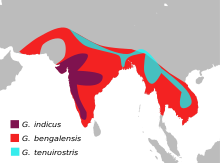Indian white-rumped vulture
| White-rumped vulture | |
|---|---|
 |
|
| Scientific classification | |
| Kingdom: | Animalia |
| Phylum: | Chordata |
| Class: | Aves |
| Order: | Accipitriformes |
| Family: | Accipitridae |
| Genus: | Gyps |
| Species: | G. bengalensis |
| Binomial name | |
|
Gyps bengalensis (Gmelin, 1788) |
|
 |
|
| Former distribution of Gyps bengalensis in red | |
| Synonyms | |
|
Pseudogyps bengalensis |
|
Pseudogyps bengalensis
The white-rumped vulture (Gyps bengalensis) is an Old World vulture native to South and Southeast Asia. It has been listed as Critically Endangered on the IUCN Red List since 2000, as the population severely declined. White-rumped vultures die of renal failure caused by diclofenac poisoning. In the 1980s, the global population was estimated at several million individuals, and it was thought to be "the most abundant large bird of prey in the world". As of 2016, the global population was estimated at less than 10,000 mature individuals.
It is closely related to the European griffon vulture (Gyps fulvus). At one time it was believed to be closer to the white-backed vulture of Africa and was known as the Oriental white-backed vulture.
The white-rumped vulture is a typical, medium-sized vulture, with an unfeathered head and neck, very broad wings, and short tail feathers. It is much smaller than the Eurasian Griffon. It has a white neck ruff. The adult's whitish back, rump, and underwing coverts contrast with the otherwise dark plumage. The body is black and the secondaries are silvery grey. The head is tinged in pink and bill is silvery with dark ceres. The nostril openings are slit-like. Juveniles are largely dark and take about four or five years to acquire the adult plumage. In flight, the adults show a dark leading edge of the wing and has a white wing-lining on the underside. The undertail coverts are black.
This is the smallest of the Gyps vultures, but is still a very large bird. It weighs 3.5-7.5 kg (7.7-16.5 lbs), measures 75–93 cm (30–37 in) in length, and has a wingspan of 1.92–2.6 m (6.3–8.5 ft).
This vulture builds its nest on tall trees often near human habitations in northern and central India, Pakistan, Nepal, Bangladesh and southeast Asia, laying one egg. Birds form roost colonies. The population is mostly resident.
...
Wikipedia

